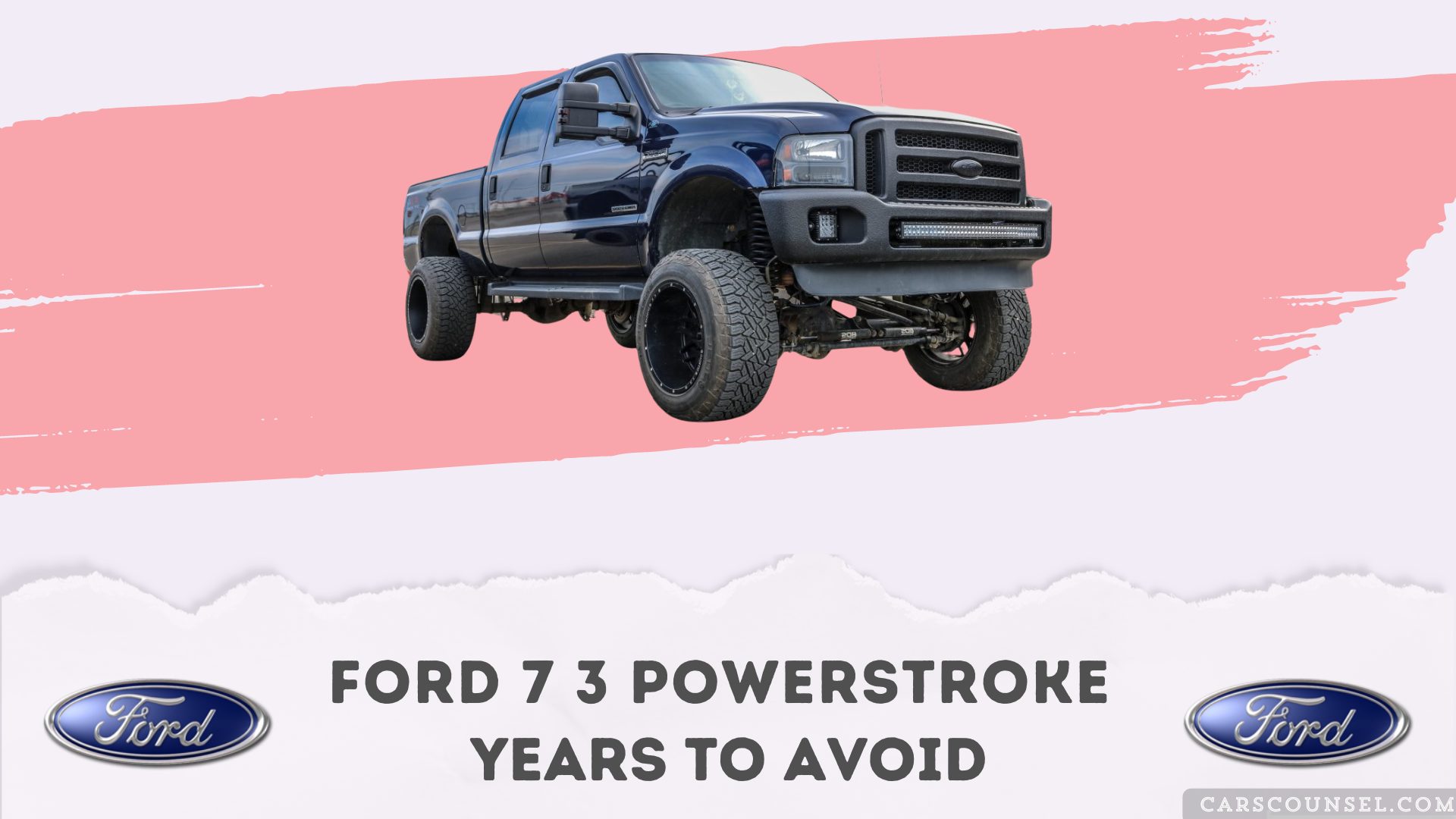You might not know that some years of the Ford 7.3 Powerstroke engine are best avoided. While many people praise its durability, the models from 1994-1998 and 2001-2003 have significant issues that can affect performance and reliability.
The earlier years had lower horsepower, and the later ones had engine failures that could lead to expensive repairs.

Curious about the specific problems these models face? Knowing these issues and which years to avoid could save you both time and money when choosing a used truck.
Quick Navigation
Key Takeaways
- Steer clear of the 1994-1998 models because they have lower horsepower and no turbocharging.
- The 2001-2003 models often have engine failures due to weak metal rods.
- Early 2001 models have big transmission problems that can be expensive to fix.
- If you’re looking at a 2001 model, check the build date to avoid issues with the mechanical diode transmission.
- Early 7.3 Powerstroke engines commonly have performance and reliability problems.
History of the 7.3 Powerstroke
When Ford rolled out the 7.3 Powerstroke engine in 1994, it represented a major advance in diesel engine technology for their F-250 and F-350 trucks. This engine, made by Navistar International Corporation, quickly earned a reputation for being reliable and strong.
A big part of its success was the direct injection technology, which made it more fuel-efficient and powerful. However, not all 7.3 Powerstroke engines are the same. Some had forged rods that made them tougher, while others, especially those from 2001-2003, had powdered metal rods and are known for being less reliable.
The early models from 1994 to 1998 had less horsepower, but starting in 1999, the engines got more powerful, making the newer models more appealing.
1994-1998 Model Years
When looking at the 1998 Ford 7.3 Powerstroke, you’ll see it has less horsepower compared to other years.
Early models had some problems and needed performance upgrades, making it less reliable.
For a more dependable truck, you should consider other model years.
Lower Horsepower Output
The 1994-1998 Ford 7.3 Powerstroke models might not have enough horsepower for your performance and towing needs. These trucks come with a diesel engine that has less power compared to newer versions. If you need a truck for heavy towing and hauling, these older models might not be strong enough.
Here’s a quick comparison:
| Model Year | Engine Type | Horsepower |
|---|---|---|
| 1994 | 7.3 Powerstroke | 215 HP |
| 1995 | 7.3 Powerstroke | 215 HP |
| 1996 | 7.3 Powerstroke | 225 HP |
| 1997 | 7.3 Powerstroke | 225 HP |
| 1998 | 7.3 Powerstroke | 235 HP |
Choosing a model from 1999 or newer can give you the extra power you need.
Early Model Issues
Early versions of the Ford 7.3 Powerstroke, especially from 1994 to 1998, had reliability problems that could be frustrating for owners. These models didn’t perform as well as later versions and missed out on many improvements.
The engines from 1994 to 1998 had lower horsepower, which affected their overall performance. They also lacked the technological advancements and better features found in newer models. Because of this, these early years mightn’t be as dependable as the newer ones.
If you’re thinking about getting a Ford 7.3 Powerstroke, it’s a good idea to look for models made after the early 1990s to avoid these common issues.
Performance Improvements Needed
Improving the performance of the 1994-1998 Ford 7.3 Powerstroke models mainly involves dealing with their lack of turbocharging, which limits their horsepower and torque.
Without a turbocharger, these early models have lower power and towing capabilities. To unlock their full potential, consider adding a turbocharger. This can significantly increase horsepower and torque, making the engine more efficient.
Additionally, optimizing the fuel system can further boost performance, leading to better acceleration and fuel economy.
2001-2003 Model Years
If you’re looking at Ford trucks, it’s good to know that the 2001-2003 models with the 7.3 Powerstroke engine have some issues. These trucks use powdered metal rods in the engine, which often cause engine failures. This can lead to expensive repairs and a lot of downtime, making these trucks less dependable.
Many experts suggest avoiding these specific years to avoid the hassle and cost of these problems. Choosing other model years can help you get better reliability and performance.
Transmission Issues
When looking at a Ford 7.3 Powerstroke, be aware of the transmission problems, especially in early 2001 models. These trucks often have transmissions with mechanical diodes that tend to fail, leading to repairs costing over $4,000.
Checking the transmission’s build date can help you avoid these expensive issues.
Early 2001 Failures
Early 2001 models of the Ford 7.3 Powerstroke are well-known for their transmission problems, so it’s important to check when the transmission was built before buying. These models often used mechanical diode transmissions, which had a lot of issues.
If you’re thinking about getting an early 2001 model, keep in mind the potential transmission troubles and make sure the truck is well-maintained. Because these trucks are getting older, it’s hard to find one in good condition.
Replacing the transmission in these models can cost over $4,000.
Mechanical diode transmissions were common in early 2001 versions.
Checking the build date helps you spot potentially bad transmissions.
Well-maintained trucks from this period are getting rarer.
Knowing this can help you avoid expensive repairs and headaches.
Mechanical Diode Concerns
Why should you be particularly concerned about the mechanical diode in early 2001 Ford 7.3 Powerstroke transmissions? The answer is simple: it affects the transmission’s reliability. Early 2001 models often have problems with mechanical diode failures, leading to major issues and expensive repairs. If you’re thinking about buying one of these trucks, you should check the transmission build date to see if it has the problematic mechanical diode.
Here’s a quick overview:
| Aspect | Detail |
|---|---|
| Issue | Mechanical diode failure |
| Model Year | Early 2001 |
| Impact on Reliability | Significant |
Because of these concerns, finding a well-maintained truck from this period can be tough. It’s important to check the build date and think about these factors before deciding to buy.
Costly Replacement Repairs
Expensive Repairs
Transmission replacements for early 2001 7.3 Powerstroke models can cost over $4,000 due to frequent mechanical diode failures. These models are known for their problematic transmissions, leading to pricey repairs.
If you’re in the market for a well-maintained truck, checking the build date is crucial to avoid these common issues.
To keep the truck reliable and save money, follow these steps:
- Check the build date before buying.
- Look at service records for any transmission work.
- Have a trusted mechanic do a thorough check.
- Prepare for potential costs, as repairs can be expensive.
Engine Features and Changes
When looking at the features and changes in the 7.3 Power Stroke engine, it’s crucial to consider the impact of PMR rods and mechanical diode transmissions on how well the engine performs and how long it lasts.
PMR rods, or powdered metal rods, showed up inconsistently in various model years and could be less reliable than the forged ones. Early 2001 models often had mechanical diode transmissions, which had mixed reviews on their performance.
It’s important to check these engine features carefully since they directly affect how long the engine will last. Also, some 7.3 Power Stroke models didn’t have turbos, which greatly reduced their power and overall durability.
Knowing about these changes helps you make better decisions about the 7.3 Power Stroke’s performance and reliability in different model years.
Identifying Rod Types
To figure out if a 7.3 Power Stroke engine has forged rods or powdered metal rods, you’ll need to check the serial numbers. This is important for understanding the engine’s reliability and performance. Here’s how to tell the difference:
- Serial numbers 1425746, 1440713 – 1498318: These mean the engine has forged rods.
- Serial numbers 1425747 – 1440712, 1498319: These mean the engine has powdered metal rods.
Knowing whether an engine has forged rods or powdered metal rods can help you better assess its long-term reliability and performance.
- Forged rods: These are known for being very strong and durable.
- Powdered metal rods: These were phased out because they weren’t as durable.
Common Problems
One of the most common problems with the 7.3 Powerstroke engine is a bad Camshaft Position Sensor. Issues with the Under Valve Cover Harness Connectors can also mess up engine performance. If the Injector Pressure Regulator Valve (IPR) has problems, it can cause rough idling, stalls, or trouble starting the engine. Turbocharger Up-Pipes and the EGR cooler are other frequent trouble spots that can decrease reliability.
Here’s a quick rundown of common problems:
| Problem | Symptoms | Solution |
|---|---|---|
| Camshaft Position Sensor | Engine stalling | Replace the sensor |
| Under Valve Cover Harness Connectors | Misfiring, power loss | Inspect and fix the connectors |
| Injector Pressure Regulator Valve (IPR) | Rough idle, starting issues | Clean or replace the valve |
| Turbocharger Up-Pipes | Exhaust leaks, power loss | Replace the up-pipes |
Using forged rods instead of powdered metal rods can help prevent engine failures. Keeping an eye on oil pressure is also crucial for maintaining engine health.
When looking at performance cars, make sure to check out our guides on models like the Ford Edge, Ford Escape, Ford Expedition and Ford Explorer. Knowing which model years to target and which to avoid is crucial. Our expert reviews break down these models, providing insights into the years that are celebrated for their engineering excellence and driving satisfaction, as well as those that are best to avoid due to potential issues.
Conclusion
If you’re considering a Ford 7.3 Powerstroke, you might want to avoid the 1994-1998 and 2001-2003 models. It’s kind of funny that an engine known for its durability has some years you should steer clear of.
By skipping these specific years, you can avoid issues like lower horsepower, unreliable turbocharging, and those troublesome powdered metal rods.
Isn’t it ironic that by avoiding certain years, you actually end up with a more reliable engine?

